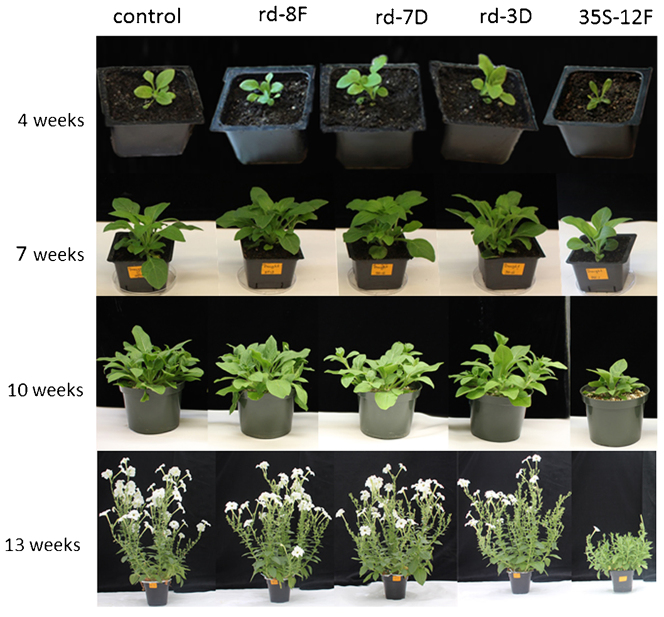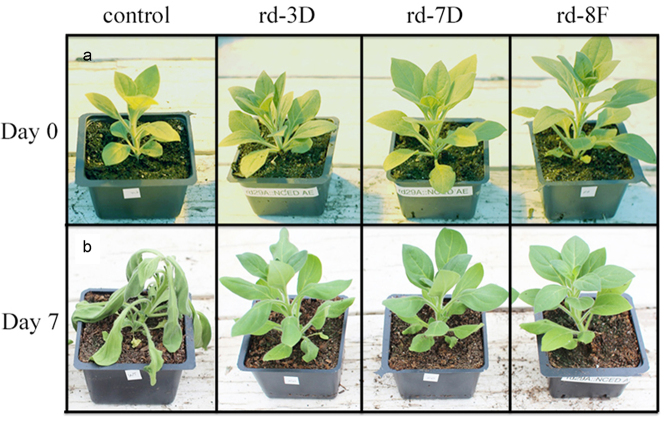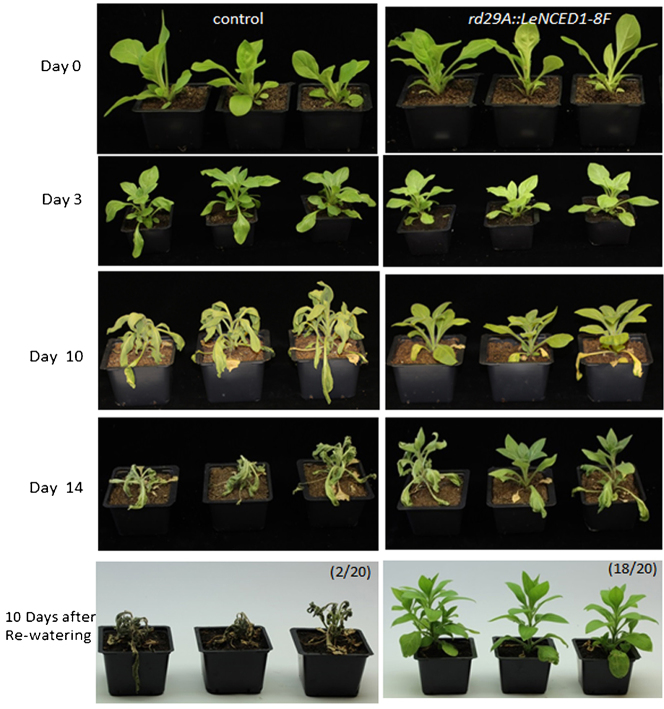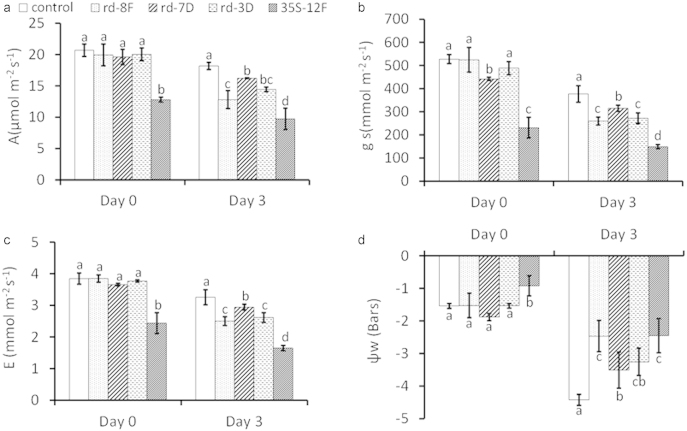Abstract
The response of plants to drought stress includes reduced transpiration as stomates close in response to increased abscisic acid (ABA) concentrations. Constitutive overexpression of 9-cis-epoxycarotenoid dioxygenase (NCED), a key enzyme in ABA biosynthesis, increases drought resistance, but causes negative pleiotropic effects on plant growth and development. We overexpressed the tomato NCED (LeNCED1) in petunia plants under the control of a stress-inducible promoter, rd29A. Under water stress, the transgenic plants had increased transcripts of NCED mRNA, elevated leaf ABA concentrations, increased concentrations of proline, and a significant increase in drought resistance. The transgenic plants also displayed the expected decreases in stomatal conductance, transpiration, and photosynthesis. After 14 days without water, the control plants were dead, but the transgenic plants, though wilted, recovered fully when re-watered. Well-watered transgenic plants grew like non-transformed control plants and there was no effect of the transgene on seed dormancy.
Introduction
Drought, the major abiotic stress constraining agricultural production, 1 is a complex stress. Plants have evolved diverse strategies to respond to drought, depending on the timing, severity, and duration of drought in their native habitat. 2 Drought stress can be defined as the lack of the minimum amount of water to supply the basal requirements of otherwise well-adapted plants and drought resistance simply as the ability of the plant to survive under drought conditions and to recover following rehydration. Global climate change is expected to increase the occurrence of drought periods in some parts of the world; improving plant growth under water-limited conditions will therefore become one of the most challenging tasks for growers of all plant crops. 3
Breeding for drought resistance would seem to be straightforward. Growing an outcrossed population under water-stressed conditions and then selecting the best lines for subsequent rounds of crossing should provide genotypes that are more resistant to drought. Unfortunately, such plants seldom perform well under favorable conditions. This suggests the potential for using a molecular genetic approach, either by increasing transcription of native genes that provide drought resistance or by introducing such genes from other species.
Obvious targets for this approach are genes involved in the synthesis and response to abscisic acid (ABA), the plant hormone that mediates the response of plants to stresses such as drought, cold, and salinity. 4 Drought stress triggers increased tissue ABA concentrations, and the ABA signaling cascade results in stomatal closure, and reduced transpiration. 5,6 When the water stress is removed, ABA concentrations fall, through catabolism and conjugation. 7 The ability of plants to control endogenous ABA levels and regulate the stomatal aperture during water stress has been a useful tool for experiments in improving drought resistance. 8
Prolonged exposure to osmotic stress that results from dehydration is the likely cause of tissue death in drought-stressed plants. In addition to stomatal closure, plants respond to increased ABA concentrations by activating osmotic-responsive genes. These genes encode proteins that help plants maintaining water uptake under drought stress by accumulating solutes, thus lowering water potential, preserving cell turgor, and minimizing water loss. 9 There are two major mechanisms for osmotic adjustment, the accumulation of inorganic ions such as K+, Cl−, and Na+ or the accumulation of organic solutes (also called compatible solutes) that reduce the osmotic potential of the tissue. The mechanism employed varies among species, cultivars, and even by position within the same plant. 10
The most common compatible solutes accumulated during osmotic adjustment are sugar alcohols such as mannitol, quaternary ammonium compounds such as betaine, and amino acids such as glycine and proline. Proline is also considered to protect plant cells from toxic by-products produced in response to drought. Yamada et al. 11 demonstrated in transgenic petunia plants that overexpression of pyrroline-5-carboxylate synthetase (P5CS), which is a key gene in proline biosynthesis, increased proline levels and improved plant resistance to drought stress.
ABA also acts as a signal for the induction of dehydration resistance genes, 12 which, in addition to protecting the cells from stress, regulate other genes involved in the response to drought stress. These genes include the late embryogenesis abundant (LEA) genes that provide desiccation tolerance during seed maturation, water transporters such as aquaporins, detoxification enzymes like superoxide dismutase and catalase, protein kinases, phosphatases and transcription factors that act as regulatory molecules. 13
ABA biosynthesis is initiated in plastids where the C40 carotenoid xanthophyll zeaxanthin is synthesized from isopentenyl diphosphate (IPP). Epoxidation of zeaxanthin by zeaxanthin epoxidase (ZEP) 14 results in another C40 compound, violaxanthin, which is converted into neoxanthin through isomerization. Neoxanthin is oxidatively cleaved by 9-cis-epoxycarotenoid dioxygenase (NCED) to yield xanthoxin, the first C15 intermediate in ABA biosynthesis. 15 Xanthoxin is exported from the plastid to the cytosol and is converted in a two-step reaction to ABA with ABA aldehyde as the intermediate. 16,17 NCED is considered to be the rate-limiting step in ABA biosynthesis; the gene encoding the enzyme was first cloned from the ABA-deficient maize mutant vp14. 18
Overexpression of NCED has been shown to result in ABA accumulation and increased drought resistance in tomato (Solanum lycopersicum), 19 Arabidopsis thaliana, 20,21 and tobacco (Nicotiana tabacum). 22,23 These studies all used a constitutive promoter CaMV-35S to drive expression of NCED genes, with negative pleiotropic effects on plant growth and development, including stunted growth, delayed germination, and seed dormancy. 19,24
Overexpression of LeNCED1 in tomato under the control of the tissue-specific promoter rbcS3C generated transgenic plants with much higher ABA levels in leaves and sap while the effect on seed dormancy was reduced. However in non-stressed conditions, these plants showed reduced stomatal conductance and CO2 assimilation, increased photobleaching in young seedlings, reduction in chlorophyll and carotenoid content, interveinal water soaking, and greatly reduced growth. 24
We sought a strategy that would stimulate transcription of an NCED transgene only under stress conditions. For this purpose we selected the stress-inducible promoter rd29A from Arabidopsis to drive expression of a tomato LeNCED1 in petunia. The cis-acting region of the rd29A promoter contains three dehydration-responsive elements and one abscisic acid responsive element. The promoter functions in almost all vegetative organs and tissues during water stress. 25
We hypothesized that under water stress conditions, the overexpression of LeNCED1 using the stress-inducible promoter rd29A would increase the ABA and proline concentration in leaves, leading to stomatal closure, reducing the osmotic potential and enhancing drought resistance in petunia, while under non-stress conditions, there would be no negative effects on plant growth and development.
Materials and methods
Plant materials and growth conditions
Petunia (Petunia hybrida ‘Mitchell Diploid’), obtained from Goldsmith Seeds (Gilroy, CA, USA), was used as a control and as the material for petunia Agrobacterium-mediated transformations. Petunia seeds were sterilized and germinated on a solid MS medium 26 in a growth chamber at 22 °C with light intensity of 40 µmol/m2/s. Seedlings with two true leaves were then carefully transferred into pots containing the same amounts of UC Mix (1/3 Peat, 1/3 Sand, 1/3 redwood compost), and grown in a greenhouse at University of California Davis under natural conditions without supplement lights at 25–30 °C.
Plasmid constructs
For the cloning of the rd29A promoter, a 1626 bp fragment of rd29A (GenBank Accession No. CS191722.1) in the upstream 5′ noncoding region was amplified from wild-type Arabidopsis genomic DNA using the primers (Supplementary Table S1). The 2222 bp coding region of LeNCED1 cDNA (GenBank Accession No. AJ439079.2) was amplified from tomato (Solanum lycopersicum Mill. L. cv. New Yorker) using the cloning primers (Supplementary Table S1). The PCR products were cloned into pGEM-T easy vector (Promega, Madison, WI, USA) for sequence confirmation by the sequencing service of the College of Biological Sciences at University of California Davis.
After sequence confirmation, the LeNCED1 gene was introduced into a modified pGSA1403 binary expression vector 27 in which the CaMV-35S promoter was replaced with the rd29A promoter (Supplementary Figure 1). For transgenic plants that were used as a constitutively expressed control, the LeNCED1 gene was introduced into the pGSA1403 binary vector downstream of the CaMV-35S promoter. The expression constructs, containing the kanamycin resistance gene for selection, were used for plant transformation.
Plant transformation
Petunia (Petunia hybrida ‘Mitchell Diploid’) was transformed via Agrobacterium tumefaciens strain LBA4404. Plants were transformed at the UC Davis transformation facility. 28 At the fourth to sixth leaf stage, the kanamycin-resistant primary transformants (T0) were screened using polymerase chain reaction (PCR) to determine whether the plants contained the transgene. 28,29
Lines containing the transgene were then transferred into pots containing same amounts of UC Mix (1/3 Peat, 1/3 Sand, 1/3 redwood compost) and grown in a greenhouse under natural conditions without supplement lights at 25–30 °C until flowering. Plants then were self-pollinated to prevent cross-pollination. T1 seeds that displayed a 3∶1 ratio of survival on kanamycin were collected at maturity and used for further analysis.
Seeds of T1 transgenic lines were sterilized, germinated at room temperature under controlled illumination (14 h of light) on a solid MS medium, 26 and supplemented with 100 mg L−1 kanamycin for selection of segregated progeny. Seeds from non-transformed control plants were germinated and grown on a solid MS medium without kanamycin. To identify homozygous lines, seedlings from selected lines were transferred to pots filled with same amounts of UC Mix and grown in a greenhouse with natural illumination at 25–30 °C until they set seed. One hundred seeds from each line were germinated again on MS medium containing 100 mg L−1 kanamycin. Three transgenic rd29A:LeNCED1 lines (8F, 7D, and 3D) showing 100% survival were selected as homozygous and used for molecular analysis and physiological assessments. In addition, one CaMV-35S:LeNCED1 line 12-F was selected to serve as a control. Due to low germination, stunted growth and leaf photobleaching, this line was only used for limited experiments.
Semi-quantitative RT-PCR
To determine the expression of the LeNCED1 and PhP5CS genes in non-transformed and transgenic petunia plants, RNA extracted from the leaves of T3 plants was analyzed using semi-quantitative RT-PCR. Prior to the extraction, plants were drought stressed by withholding water for 3 days. RNA was extracted from harvested leaves using TRIzol reagent (Invitrogen, CA, USA) according to the manufacturer’s instructions. After DNase I treatment to remove contaminating DNA, 1 µg of total RNA was used for reverse transcription using the Superscript II Reverse Transcriptase Kit (Invitrogen, CA, USA) according to the manufacturer’s protocol. The synthesized cDNA was used for analysis of transcript abundance using semi-quantitative RT-PCR and the primers shown in Supplementary Table S1. Gene expression levels were compared to the expression levels of 26S ribosomal RNA. 28 Semi-quantitative PCR reactions were carried out in 25 µL volumes containing 1 µl reverse transcription reaction products as templates. PCR products were analyzed by 1% (w/v) agarose gel electrophoresis. Three biological replications were used for the analysis.
The gel images from the semi-quantitative PCR analyses were quantified using the Gel Logic 200 software (Kodak, Rochester, NY). The mean area value of the three biological replicates was used to determine relative expression levels. Graphs were generated and statistically analyzed by one-way analysis of variance (ANOVA) using JMP (SAS Institute Inc., Cary, NC, USA). Student’s t-test was used to examine significance of differences between treatments using a P value of 0.05.
ABA analysis
To determine ABA concentrations, two fully expanded leaves nearest to the apical meristem were collected and immediately frozen in liquid nitrogen. The tissues were lyophilized and placed at −80 °C until extraction. Approximately 100 mg samples were ground in liquid nitrogen and homogenized for 24 h in the dark at 4 °C in 80% chilled methanol containing 100 mg l−1 butylated hydroxytoluene. After centrifugation, the supernatant was collected, purified through a Sep-Pak C18 cartridge column (Waters Inc., Milford, MA, USA) and eluted with 70% methanol. ABA content was determined using the enzyme-linked immunosorbent assay (ELISA) test kit (Agdia/Phytodetek, Elkhart, IN, USA) according to the manufacturer’s instructions. All measurements were made from three individual plants as replicates and the results are expressed as nanomole ABA per gram fresh weight of tissue.
Proline determination
Proline content was measured spectrophotometrically based on proline’s reaction with ninhydrin as described by Bates et al. 30 with modifications. The fully expanded leaves from transgenic and wild-type plants were sampled. Fresh leaves (100 mg) were frozen in liquid nitrogen and ground in a mortar and pestle in 0.5 ml of 3% aqueous sulfosalicylic acid. The resulting supernatant was added to the reaction mixture of 100 µL 3% sulfosalicylic acid, 200 µL glacial acetic acid and 200 µL acidic ninhydrin. The reaction mix was incubated at 100 °C for 60 min, then extracted with 1 ml toluene. Absorbance at 520 nm was determined in a NanoDrop 2000c UV-Vis spectrophotometer (Thermo Fisher Scientific Inc., Waltham, MA USA) using toluene as a reference. The concentration of proline was determined by reference to a standard concentration curve.
Drought response
Eighteen rd29A:LeNCED1-8F and non-transformed petunia seedlings (2 weeks old) were transplanted into 4-inch pots containing same amounts of UC Mix. Pots were covered with aluminum foil to prevent any loss of water by evaporation from the soil surface. The plants were grown for 3 weeks in a greenhouse (natural illumination at 25–30 °C) under well watered conditions (pot capacity). At this point (day 0), the pots were weighed, and this value was considered to be 100% water content. Drought stress was then imposed by withholding water for 9 days, at which point most leaves of the non-transformed plants were wilted. The pots were weighed every morning (9:00–10:00 a.m.) for determination of percentage water loss.
Recovery after severe drought
After the drought treatment (14 days), plants were re-watered, and 10 days later the plants that displayed full turgor and resumed their growth were counted as recovered plants.
Effect of drought stress on ABA and proline content
Transgenic and non-transformed Petunia seedlings were transplanted into 4-inch pots containing UC Mix. Four weeks after transplanting, second and third leaves of transgenic and non-transformed plants were harvested to serve as controls. The remaining plants were drought stressed by withholding water. The second and third leaves of transgenic and non-transformed plants were harvested from each plant for determination of ABA and proline content 3 days after treatment.
Seed germination
To evaluate the effect of the rd29A:LeNCED1 construct on seed germination, seeds of non-transformed and transgenic Petunia plants were sterilized and sown (100 seeds per assay) on Petri plates containing standard MS agar medium. Plates were held at 24 °C in 16 to 8-h light/dark cycles. Germination was scored when two fully expanded green cotyledons had developed. The experiment was repeated three times.
Gas-exchange measurements
We analyzed the effects of the LeNCED1 transgene on net photosynthesis rate (A), stomatal conductance (gs), and transpiration rate (E) using a portable photosynthesis system (model LI-6400, LI-COR Biosciences, Lincoln, NE, USA). Measurements were made on the uppermost fully expanded leaves of five individual transgenic plants using a photon flux density of 1000 µmol.m−2.s−1 and a CO2 concentration of 400 µmol.mol−1. Non-transformed and CaMV-35S:LeNCED1 plants served as controls.
Stem water potential measurement
Stem water potential was measured using the bagged leaf technique in a Scholander-type pressure chamber. 31 Fully expanded leaves near the stem at similar positions were used. Measurements were conducted at midday. 31
Stomatal density
To measure leaf stomatal density a leaf imprint method was used. Three fully developed leaves for each plant and three mature plants were sampled. A drop of methacrylate glue (Crazy Glue) was applied to the adaxial and abaxial side of three different areas of each leaf, avoiding the midvein, and the leaf was pressed to a glass slide for 30 s. The leaf was removed and the imprint on the glass slide was observed using a light microscope.
Flower senescence
Ten flowers from plants of each transgenic line and from control plants were harvested when flowers were fully open but before the anthers had dehisced. Flowers were placed in 2 ml tubes containing a standard vase solution (Chrysal, Walterboro, SC, USA). Flowers were monitored daily and were scored as senesced when the corolla wilted. To determine the longevity of attached flowers, 10 fully open flowers of each transgenic line and of control plants were labeled, then monitored daily until their corollas were completely wilted.
Data analysis
All measurements were repeated at least three times from different individual plants. All data were subject to ANOVA according to the model for completely randomized design using Proc GLM (generalized linear model) with LSD means separation (least significant difference test; P ≤ 0.05). Values were analyzed by JMP Version 11 (SAS Institute Inc., Cary, NC, USA).
Results
Screening and characteristics of rd29A:LeNCED1 lines
Following self-pollination and kanamycin selection of 12 T0 lines obtained from the transformation facility, we selected three homozygous T2 transgenic rd29A:LeNCED1 lines 8F, 7D, and 3D. These plants exhibited normal growth and development under non-stress growth conditions (Figure 1). Anatomically, too, the plants were indistinguishable; we found no significant differences in stomatal density or stomatal index on abaxial and adaxial leaf surfaces between the transgenic rd29A:LeNCED1 and control plants (data not shown). T3 seedlings of these lines were used for further experiments. One homozygous line CaMV-35S:LeNCED1-12F, was used as a constitutive expression control in limited experiments. Under non-stressed conditions, the seeds from CaMV-35S:LeNCED1 plants showed low germination rate and the plants grew more slowly than the non-transformed control and rd29A:LeNCED1 plants (Figure 1), and older plants developed a severe photobleaching phenotype (Supplementary Figure 4).
Figure 1.
Phenotypes of LeNCED-overexpressed petunia. The seedlings from non-transformed control, transgenic rd29A:LeNCED1 lines 8F, 7D, 3D, and CaMV-35S:LeNCED1-12F were grown in UC Mix soil in greenhouse. Daily irrigations were provided to maintain optimal non-stress growth conditions. Photographs were taken at different stages of development (4, 7, 10, and 13 weeks after sowing).
In the germination assay, 95% of seeds from non-transformed plants germinated within 10 days. Seeds of the rd29A:LeNCED1 lines, 8F, 7D, and 3D, gave germination rates of 95, 90, and 92% respectively. Only 50% of the seeds from the CaMV-35S:LeNCED1 plants had germinated after 10 days (Supplementary Figure 2b). Germination was restored to the levels of the control seeds when CaMV-35S:LeNCED1 seeds were treated with 500 ppm GA (Supplementary Figure 2c).
Drought stress response of vegetative plants
After 6 weeks in the greenhouse under normal conditions there were no visible differences in phenotype between the rd29A:LeNCED1 transgenic plants and control plants (Figure 2). When water was then withheld for 1 week, there was a dramatic difference. The control plants were visibly wilted, while plants of the three transgenic lines were still turgid (Figure 2).
Figure 2.
Phenotypes of control and rd 29A:LeNCED1 plants under non-stress and stress conditions. Plants of non-transformed control and transgenic rd29A:LeNCED1 (8F, 7D, and 3D) lines were grown in UC mix soils in greenhouse for 6 weeks under non-stress conditions (a) and were subjected to drought treatment by withholding irrigation for 7 days (b). Photographs taken at 7 days after drought treatment clearly showed wilting phenotype for the non-transformed control while the rd29A:LeNCED1 lines showed no apparent negative impact on the growth and development.
Recovery from drought stress
The recovery experiment compared control and rd29A:LeNCED1-8F plants. Control plants started to wilt at 3 days of drought (Figure 3) and were severely wilted by 10 days. At that time the transgenic plants showed wilting and yellowing only of the older (basal) leaves (Figure 3). After 2 weeks without water, the control plants were completely desiccated, and some transgenic plants were severely wilted, although their apices remained turgid. The plants were re-watered after 2 weeks of drought stress (Figure 3). Only 11% of the control plants survived, whereas 94.4% of the rd29A:LeNCED1 transgenic plants recovered completely.
Figure 3.
Drought stress resistance of rd29:LeNCED petunia. Plants of non-transformed control and transgenic rd29A:LeNCED1 line 8F were grown in pots filled with same amounts of UC Mix under non-stress conditions for 5 weeks and were subjected to drought stress by withholding water for 14 days. The control plants started wilting at day 3 and were severely wilted by day 10. In comparison, transgenic plants started to show wilting at day 10. The stressed plants were rehydrated to allow recovery and photographs were taken 10 days after re-watering. The number of surviving plants (out of the total tested) was indicated on the upper right of the image.
Drought stress response of flowering plants
After 12 weeks in the greenhouse, the rd29A:LeNCED1 and control plants were flowering and were visually indistinguishable (Supplementary Figure 3). Withholding water for 10 days resulted in severe wilting of leaves and flowers in the control plants while the transgenic plants were only slightly wilted, and most of their flowers were still turgid (Supplementary Figure 3). As with the vegetative plants, most of the rd29A:LeNCED1 plants at the flowering stage recovered if they were re-watered after 15 days of drought stress; the control plants were unable to recover (Supplementary Figure 4). Transgenic plants constitutively expressing LeNCED1 also completely recovered (Supplementary Figure 4).
Effect on transpiration
Determination of water loss by measuring the pot weight of 5-week-old plants subjected to drought stress demonstrated a significant difference between non-transformed and rd29A:LeNCED1-8F plants. For the first day after stopping irrigation, water loss was similar in all plants. Thereafter there was a dramatic difference in water loss between the control and transgenic plants. Water loss from non-transformed control and from transgenic plants was almost linear for the first week of the drought stress period; the rate of water loss in the transgenic plants was half that in the controls (Figure 4). The time to visible wilting in the controls was less than half of that in the transgenic plants.
Figure 4.
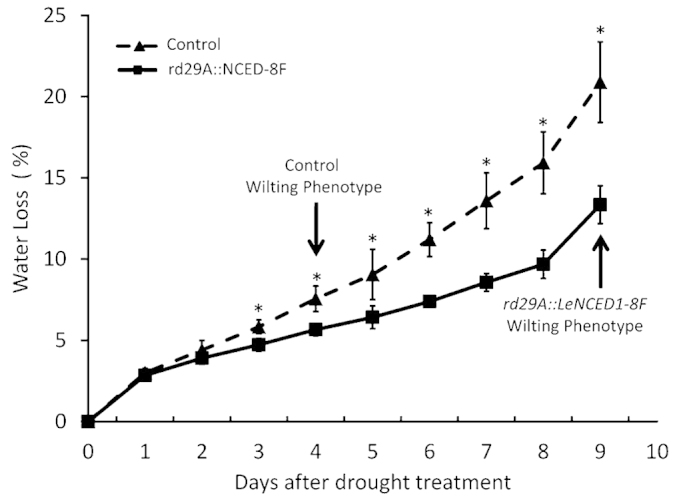
Water loss of rd29A:LeNCED petunia under drought stress. Plants of non-transformed control and transgenic rd29A:LeNCED1-8F were grown in the pots filled with same amounts of UC mix soils under well-irrigated conditions for 5 weeks and were subjected to drought stress treatment by withholding water over a period of 9 days. The weights of each pot were measured daily in the morning and water loss was calculated. The arrows mark the points when all the plants showed wilting. Each time point is presented as the mean ± SD (n = 6). Different letters denote significant differences at the 0.05 level.
LeNCED1 expression results in an increase of ABA content
LeNCED1 transcripts could not be detected in non-stressed leaves from the three rd29A:LeNCED1 transgenic lines (0 h) but were abundant in leaves from the CaMV-35S:LeNCED1 line (Figure 5a). After 3 days of drought, LeNCED1 transcript abundance had increased dramatically in leaves from the three rd29A:LeNCED1 transgenic lines and was similar to that in the CaMV-35S:LeNCED1 transgenic plants (Figure 5a).
Figure 5.
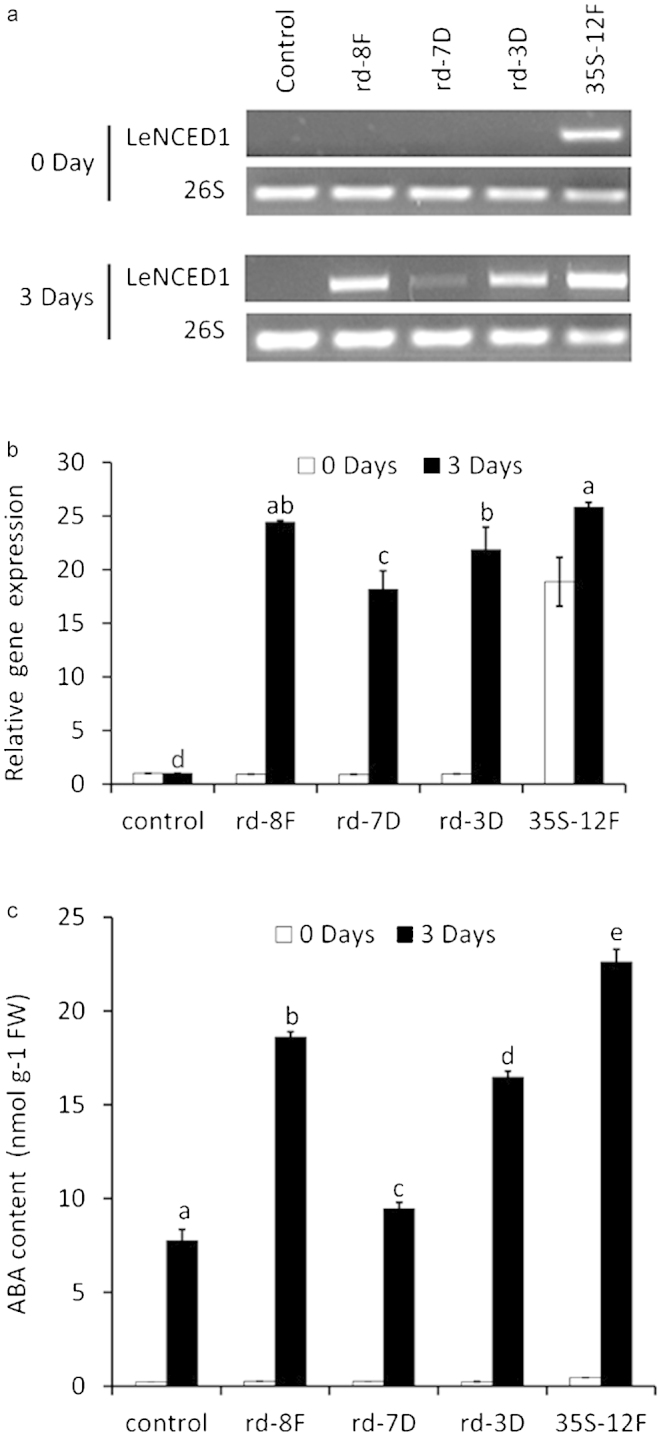
LeNCED1 expression and ABA content in LeNCED1-overexpressed petunia. Plants of non-transformed control, transgenic rd29A:LeNCED1 lines 8F, 7D, 3D, and CaMV-35S:LeNCED1-12F line were grown in UC mix soils in greenhouse for 6 weeks under non-stress conditions and were subjected to drought treatment by withholding irrigation for 3 days. Transcript abundances of the LeNCED1 were determined with semi-quantitative RT-PCR using intact leaves after 0- and 3-day drought treatment (a, b). Error bars show SE of the means of three biological replicates; different letters denote significant differences using t-test at P > 0.05. ABA contents were measured using ELISA methods as described in M & M (c). Leaf samples were taken from the non-transformed control, transgenic rd29A:LeNCED1 and CaMV-35S:LeNCED1 lines at 0 and 3 days after drought treatment. Data are means ± SD (n = 6). Different letters denote significant differences at the 0.05 level.
ABA concentrations in non-stressed leaves were low (Figure 5c); the concentration in leaves of the CaMV-35S:LeNCED1 line was twice that in the other lines. After 3 days of drought stress, ABA concentrations had increased dramatically in all plants, especially in the rd29A:LeNCED1 line 8F and in the CaMV-35S:LeNCED1 line 12F (Figure 5c).
Physiological parameters
In well-watered plants, the photosynthesis rate, transpiration rate, stomatal conductance, and stem water potential of control and rd29A:LeNCED1 plants were very similar (Figure 6). In contrast, these parameters were all significantly lower in plants of the CaMV-35S:LeNCED1 line. Drought stress reduced these physiological parameters in all plants. Photosynthesis, stomatal conductance, and transpiration in the stressed transgenic plants were lower than in the stressed non-transformed controls, but stem water potential of the controls was much lower than that in the transgenic lines (Figure 6).
Figure 6.
Leaf gas exchange and water potential in LeNCED1-overexpressed petunia. Plants of non-transformed control, transgenic rd29A:LeNCED1 lines 8F, 7D, 3D, and CaMV-35S:LeNCED1-12F line were grown in UC mix soils in greenhouse for 6 weeks under non-stress conditions and were subjected to drought treatment by withholding irrigation for 3 days. CO2 assimilation rate (a), leaf conductance (b), transpiration rate (c), and stem water potential (d) were measured using intact leaves. Error bars represent standard deviation of the mean where n = 6. Different letters denote significant differences at the 0.05 level.
Effects of drought stress on proline synthesis
Under non-stressed conditions, P5CS transcript abundance was low, but detectable in transgenic rd29A:LeNCED1 and control plants (Figure 7a). Abundance was much higher in the non-stressed CaMV-35S:LeNCED1 plants. After 3 days of drought stress, P5CS transcript abundance had increased substantially in all plants, but much more in the transgenic plants than in the controls (Figure 7b). The proline content of the plants mirrors the transcript abundance (Figure 7c); concentrations were low in non-stressed plants, although somewhat higher in the CaMV-35S:LeNCED1 plants (Figure 7c). Stressed plants all contained much higher concentrations of proline, but concentrations in the transgenic lines were double that in the controls (Figure 7c).
Figure 7.
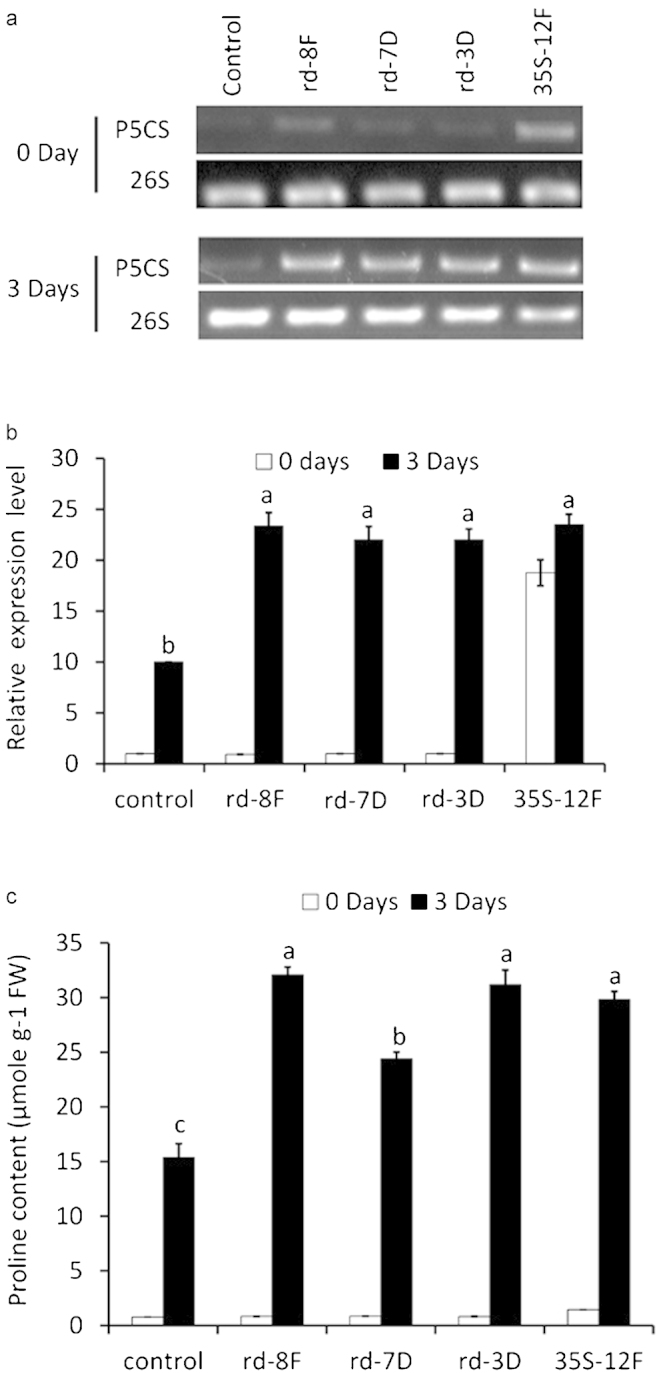
P5CS expression and proline accumulation in LeNCED1-overexpressed petunia. Plants of non-transformed control, transgenic rd29A:LeNCED1 lines 8F, 7D, 3D, and CaMV-35S:LeNCED1-12F line were grown in UC mix soils in greenhouse for 6 weeks under non-stress conditions and were subjected to drought treatment by withholding irrigation for 3 days. Relative expression levels of P5CS in petunia leaves at 0 and 3 days after drought treatment were measured by semi-quantitative RT-PCR (a, b). Proline accumulation in the control and rd29A:LeNCED1 petunia intact leaves exposed to 0 and 3 days under drought (c). Mean SD values of three independent experiments are shown. Different letters denote significant differences at the 0.05 level.
Discussion
Our data strongly support the hypothesis that overexpression of LeNCED1 using a stress-specific promoter would enhance drought resistance in petunia without negative effects on plant growth and development under non-stress conditions. Previous researchers overexpressed NCED using a constitutive promoter such as CaMV-35S. Although they found increased ABA accumulation, faster stomatal closure and enhanced drought resistance in several plants including tomato, 32 Arabidopsis, 33,34,20 Nicotiana plumbaginifolia, 23 and tobacco; 22,19 the transgenic plants showed defective growth and development, increased seed dormancy and delayed germination. 19 In the CaMV-35S:LeNCED1 petunia lines that we generated, similar effects, including a marked photobleaching phenotype in leaves of mature plants, were observed (Supplementary Figure 5).
To avoid these pleiotropic effects, we generated petunia plants overexpressing the LeNCED1 gene under the control of the stress-responsive rd29A promoter. Inducible promoters are a very powerful tool used in plant genetic engineering to regulate the expression of genes in a particular tissue or at specific stages of development. 35 In normal growth conditions, the transgenic plants were indistinguishable from the control plants (Figure 1), indicating that the transgene was tightly controlled. Even in line 7D, whose stomatal conductance was significantly reduced under non-stress conditions (Figure 6b), suggesting some ‘leakiness,’ there were only minor negative effects on plant growth and development. Seed germination rate (Supplementary Figure 2), flower longevity (Supplementary Figure 6), and stomatal density (data not shown) of the transgenic plants grown under non-stressed conditions were also similar to those of control plants.
The photobleaching symptom observed in the mature leaves of the CaMV-35S:LeNCED1 plants might be attributed to reduced production of photoprotective carotenoids 36 resulting from diversion of precursors to ABA synthesis. Since there was no photobleaching in the rd29A:LeNCED1 plants, photobleaching in the constitutive NCED plants cannot be explained in this way, and must instead be the result of other correlated effects, such as stomatal closure and limited CO2 fixation under non-stressed conditions.
One of the more remarkable responses to drought stress of the rd29A:LeNCED1 transgenic plants was their ability to recover from severe water stress. After 14 days without water, most of the transgenic plants recovered, whereas almost all of the control plants died when re-watered. This difference may simply reflect the reduction in water loss and accompanying physiological stresses in the transgenic plants, but it may also be the result of the greatly increased concentration of proline and perhaps other osmoregulatory compounds in the cells of the stressed transgenic plants. We found that the relatively low concentration of ABA in the leaves of constitutive CaMV-35S:LeNCED1 plants under non-stressed conditions had about the same effect on gas exchange as the much higher levels in the drought-stressed rd29A:LeNCED1 transgenic plants. This suggests that mechanisms other than stomatal closure are key to the improved stress resistance resulting from stress-induced overexpression of NCED.
In response to drought stress, many plants reduce their water potential to maintain turgor by accumulating compatible solutes such as proline, mannitol, or trehalose in the cytoplasm. 37,38 Proline, one of the most commonly reported compatible solutes, is important not only in osmoregulation, 39 but also in protecting cells by enhancing the stability of proteins and membranes. 40,41 The increased transcript abundance of P5CS, considered to be the rate limiting enzyme in proline biosynthesis, 42 was correlated with a significantly higher accumulation of free proline in rd29A:LeNCED1 transgenic plants during drought stress (Figure 7). Other researchers have shown correlations between endogenous increase 43 and exogenous application of ABA and proline concentrations in drought-stressed plants, but the relationship between proline and ABA in stress survival requires further examination.
Our results demonstrated that overexpression of a target gene related to ABA biosynthesis pathway such as NCED using the inducible promoter rd29A is an effective strategy for improving the drought resistance and avoiding the negative effects resulting from a constitutive promoter. Drought is a complex stress. Drought resistance can vary widely among crops; accurately assessing the drought resistance of different crops and varieties requires extensive field trials over a number of growing seasons in varied environments. Whether the approach described in this study would be widely applicable to other plants or agricultural field crops or the mechanism based on the conditionally enhanced ABA biosynthesis would be useful under field conditions requires further study. In addition, it would be informative to examine whether this approach could enhance water use efficiency and affect biomass production in the future.
Acknowledgments
This work was funded in part by United States Department of Agriculture (USDA) Floriculture Initiative (5306-21000-019-00D and 5306-13210-001-02S) and by the Plant Science Department at the University of California, Davis through the Jastro Scholarship. We thank Linda Donnelly and Lee Ann Richmond for technical assistance. Goldsmith Seeds (Gilroy, CA, USA) generously donated seeds of the Mitchell petunia cultivar.
The authors declare no conflict of interest.
References
- Boyer JS . Plant productivity and environment. Science 1982; 218: 443–448. [DOI] [PubMed] [Google Scholar]
- Gurian-Sherman D . Why genetic engineering is not solving agriculture's drought problem in a thirsty world. Report. Cambridge, MA; 2012. [Google Scholar]
- Salinger MJ , Sivakumar MVK . Motha R. Reducing vulnerability of agriculture and forestry to climate variability and change: workshop summary and recommendations. Climatic Change May 2005; 70: 341–362. [Google Scholar]
- Davies WJ , Zhang JH . Root signals and the regulation of growth and development of plants in drying soil. Annu Rev Plant Phys 1991; 42: 55–76. [Google Scholar]
- Blatt MR . Cellular signaling and volume control in stomatal movements in plants. Annu Rev Cell Dev Bi 2000; 16: 221–241. [DOI] [PubMed] [Google Scholar]
- Malladi A , Burns JK . Communication by plant growth regulators in roots and shoots of horticultural crops. Hortscience August 2007; 42: 1113–1117. [Google Scholar]
- Dietz KJ , Sauter A , Wichert K , Messdaghi D , Hartung W . Extracellular beta-glucosidase activity in barley involved in the hydrolysis of ABA glucose conjugate in leaves. J Exp Bot May 2000; 51: 937–944. [PubMed] [Google Scholar]
- Wang Y , Ying JF , Kuzma M , Chalifoux M , Sample A et al. Molecular tailoring of farnesylation for plant drought tolerance and yield protection. Plant J August 2005; 43: 413–424. [DOI] [PubMed] [Google Scholar]
- Gagneul D , Ainouche A , Duhaze C , Lugan R , Larher FR et al. A reassessment of the function of the so-called compatible solutes in the halophytic Plumbaginaceae Limonium latifolium. Plant Physiol July 2007; 144: 1598–1611. [DOI] [PMC free article] [PubMed] [Google Scholar]
- Ashraf M , Bashir A . Salt stress induced changes in some organic metabolites and ionic relations in nodules and other plant parts of two crop legumes differing in salt tolerance. Flora 2003; 198: 486–498. [Google Scholar]
- Yamada M , Morishita H , Urano K , Shiozaki N , Yamaguchi-Shinozaki K , Shinozaki K , et al. Effects of free proline accumulation in petunias under drought stress. J Exp Bot July 2005; 56: 1975–1981. [DOI] [PubMed] [Google Scholar]
- Xiong LM , Ishitani M , Lee H , Zhu JK . The Arabidopsis LOS5/ABA3 locus encodes a molybdenum cofactor sulfurase and modulates cold stress- and osmotic stress-responsive gene expression. Plant Cell September 2001; 13: 2063–2083. [DOI] [PMC free article] [PubMed] [Google Scholar]
- Roychoudhury A , Paul S , Basu S . Cross-talk between abscisic acid-dependent and abscisic acid-independent pathways during abiotic stress. Plant Cell Rep July 2013; 32: 985–1006. [DOI] [PubMed] [Google Scholar]
- Marin E , Nussaume L , Quesada A , Gonneau M , Sotta B et al. Molecular identification of zeaxanthin epoxidase of Nicotiana plumbaginifolia, a gene involved in abscisic acid biosynthesis and corresponding to the ABA locus of Arabidopsis thaliana. Embo J 15 May 1996; 15: 2331–2342. [PMC free article] [PubMed] [Google Scholar]
- Schwartz SH , Tan BC , Gage DA , Zeevaart JAD , McCarty DR . Specific oxidative cleavage of carotenoids by VP14 of maize. Science 20 Jun 1997; 276: 1872–1874. [DOI] [PubMed] [Google Scholar]
- Schwartz SH , Qin X , Zeevaart JA . Elucidation of the indirect pathway of abscisic acid biosynthesis by mutants, genes, and enzymes. Plant Physiol April 2003; 131: 1591–1601. [DOI] [PMC free article] [PubMed] [Google Scholar]
- Taylor IB , Sonneveld T , Bugg TDH , Thompson AJ . Regulation and manipulation of the biosynthesis of abscisic acid, including the supply of xanthophyll precursors. J Plant Growth Regul December 2005; 24: 253–273. [Google Scholar]
- Tan BC , Schwartz SH , Zeevaart JAD , McCarty DR . Genetic control of abscisic acid biosynthesis in maize. Proc Nat Acad Sci USA 28 October 1997; 94: 12235–12240. [DOI] [PMC free article] [PubMed] [Google Scholar]
- Thompson AJ , Jackson AC , Symonds RC , Mulholland BJ , Dadswell AR et al. Ectopic expression of a tomato 9-cis-epoxycarotenoid dioxygenase gene causes over-production of abscisic acid. Plant J August 2000; 23: 363–374. [DOI] [PubMed] [Google Scholar]
- Wan XR , Li L . Regulation of ABA level and water-stress tolerance of Arabidopsis by ectopic expression of a peanut 9-cis-epoxycarotenoid dioxygenase gene. Biochem Bioph Res Co 8 September 2006; 347: 1030–1038. [DOI] [PubMed] [Google Scholar]
- Iuchi S , Kobayashi M , Taji T , Naramoto M , Seki M et al. Regulation of drought tolerance by gene manipulation of 9-cis-epoxycarotenoid dioxygenase, a key enzyme in abscisic acid biosynthesis in Arabidopsis. Plant J 2001; 27: 325–333. [DOI] [PubMed] [Google Scholar]
- Zhang Y , Yang J , Lu S , Cai J , Guo Z . Overexpressing SgNCED1 in Tobacco Increases ABA Level, Antioxidant Enzyme Activities, and Stress Tolerance. J Plant Growth Regul 2008; 27: 151–158. [Google Scholar]
- Qin XQ , Zeevaart JAD . Overexpression of a 9-cis-epoxycarotenoid dioxygenase gene in Nicotiana plumbaginifolia increases abscisic acid and phaseic acid levels and enhances drought tolerance. Plant Physiol February 2002; 128: 544–551. [DOI] [PMC free article] [PubMed] [Google Scholar]
- Tung SA , Smeeton R , White CA , Black CR , Taylor IB et al. Over-expression of LeNCED1 in tomato (Solanum lycopersicum L.) with the rbcS3C promoter allows recovery of lines that accumulate very high levels of abscisic acid and exhibit severe phenotypes. Plant Cell Environ July 2008; 31: 968–981. [DOI] [PubMed] [Google Scholar]
- Yamaguchishinozaki K , Koizumi M , Urao S , Shinozaki K . Molecular-cloning and characterization of 9 Cdnas for genes that are responsive to desiccation in Arabidopsis-Thaliana - sequence-analysis of one Cdna clone that encodes a putative transmembrane channel protein. Plant Cell Physiol April 1992; 33: 217–224. [Google Scholar]
- Murashige T , Skoog F . A revised medium for rapid growth and bio assays with tobacco tissue cultures. Physiologia plantarum 1962; 15: 473–497. [Google Scholar]
- Chang XX , Donnelly L , Sun DY , Rao JP , Reid MS et al. A petunia homeodomain-leucine zipper protein, PhHD-Zip, plays an important role in flower senescence. Plos One 14 February 2014; 9(2): e88320. [DOI] [PMC free article] [PubMed] [Google Scholar]
- Wang H , Stier G , Lin J , Liu G , Zhang Z et al. Transcriptome changes associated with delayed flower senescence on Transgenic Petunia by inducing expression of etr1-1, a mutant ethylene receptor. Plos One 9 July 2013; 8(7): e65800. [DOI] [PMC free article] [PubMed] [Google Scholar]
- Liang YC , Reid MS , Jiang CJ . Controlling plant architecture by manipulation of gibberellic acid signalling in petunia. Hortic Res 2014; 1: 14061. [DOI] [PMC free article] [PubMed] [Google Scholar]
- Bates LS , Waldren RP , Teare ID . Rapid determination of free proline for water-stress studies. Plant Soil 1973; 39: 205–207. [Google Scholar]
- McCutchan H , Shackel KA . Stem-water potential as a sensitive indicator of water stress in prune trees (Prunus domestica L. cv. French). Amer Soc Hort Sci 1992; 117(4): 607–611. [Google Scholar]
- Thompson AJ , Andrews J , Mulholland BJ , McKee JM , Hilton HW et al. Overproduction of abscisic acid in tomato increases transpiration efficiency and root hydraulic conductivity and influences leaf expansion. Plant Physiol April 2007; 143: 1905–1917. [DOI] [PMC free article] [PubMed] [Google Scholar]
- Iuchi SK , Kobayashi M , Taji T , Naramoto M ; Seki M et al. Regulation of drought tolerance by gene manipulation of 9-cis-epoxycarotenoid dioxygenase, a key enzyme in abscisic acid biosynthesis in Arabidopsis.-2001.pdf. Plant J 2001; 27: 325–333. [DOI] [PubMed] [Google Scholar]
- Lefebvre V , North H , Frey A , Sotta B , Seo M et al. Functional analysis of Arabidopsis NCED6 and NCED9 genes indicates that ABA synthesized in the endosperm is involved in the induction of seed dormancy. Plant J February 2006; 45: 309–319. [DOI] [PubMed] [Google Scholar]
- Dutt M , Dhekney SA , Soriano L , Kandel R , Grosser JW . Temporal and spatial control of gene expression in horticultural crops. Hortic Res 2014. 09/24/online; 1: 14047: doi:14010.11038. [DOI] [PMC free article] [PubMed] [Google Scholar]
- Demmigadams B , Adams WW . Photoprotection and other responses of plants to high light stress. Annu Rev Plant Phys 1992; 43: 599–626. [Google Scholar]
- Csonka LN . Physiological and genetic responses of bacteria to osmotic-stress. Microbiol Rev March 1989; 53: 121–147. [DOI] [PMC free article] [PubMed] [Google Scholar]
- Chen THH , Murata N . Enhancement of tolerance of abiotic stress by metabolic engineering of betaines and other compatible solutes. Curr Opin Plant Biol June 2002; 5: 250–257. [DOI] [PubMed] [Google Scholar]
- Samaras Y , Bressan RA , Csonka LN , Garcia-Rios MG , Paino D'Urzo M et al. Proline accumulation during drought and salinity. In: Smirnoff N , ed. Environment and plant metabolism: flexibility and accumulation. Oxford, UK: BIOS Scientific Publishers 1995; p161–187. [Google Scholar]
- Hare PD , Cress WA . Metabolic implications of stress-induced proline accumulation in plants. Plant Growth Regul February 1997; 21: 79–102. [Google Scholar]
- Kishor PBK , Sangam S , Amrutha RN , Laxmi PS , Naidu KR et al. Regulation of proline biosynthesis, degradation, uptake and transport in higher plants: its implications in plant growth and abiotic stress tolerance. Curr Sci India 10 February 2005; 88: 424–438. [Google Scholar]
- Hu CAA , Delauney AJ , Verma DPS . A bifunctional enzyme (delta-1-pyrroline-5-carboxylate synthetase) catalyzes the 1st 2 steps in proline biosynthesis in plants. Proc Nat Acad Sci USA 1 October 1992; 89: 9354–9358. [DOI] [PMC free article] [PubMed] [Google Scholar]
- Zhou L , Xu H , Mischke S , Meinhardt LW , Zhang D et al. Exogenous abscisic acid significantly affects proteome in tea plant (Camellia sinensis) exposed to drought stress. Hortic Res June 2014; 1: 14029. [DOI] [PMC free article] [PubMed] [Google Scholar]
Associated Data
This section collects any data citations, data availability statements, or supplementary materials included in this article.



